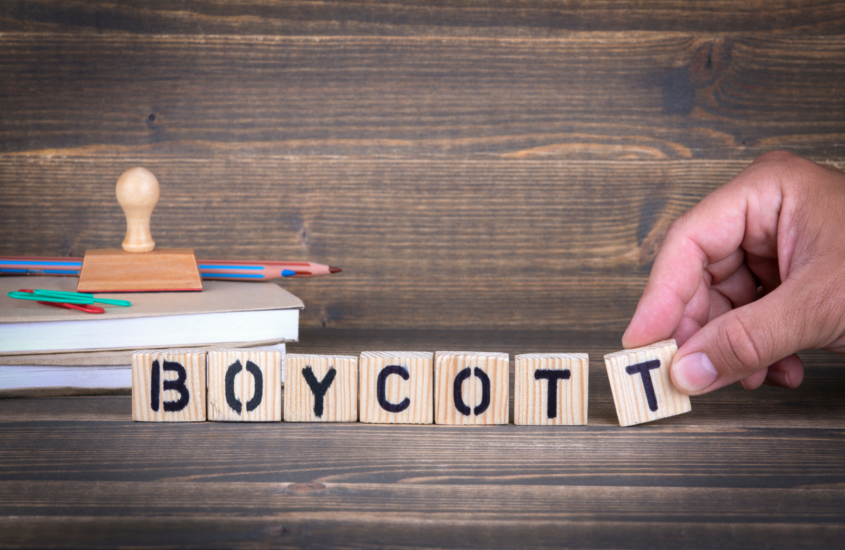The Anatomy of a Boycott
AmericanMom Team |
Let’s be honest; historically, moderates, the right and conservatives have been terrible at boycotting things. When it comes to taking a stand, we’re often a little too nice. We might get angry, post about it on social media, maybe even stop shopping somewhere for a while. But, inevitably, things go back to normal. We’ve been compliant a little too long, and it’s starting to show in all areas of our society. Well, recently, we’ve gained some steam—and a little bit of a spine—and have collectively brought a few companies to their knees—or, at least, we’ve made them wobbly on their feet. The point is, we’ve taken a real stand and have seen real results. But what does it mean to actually boycott? And are we doing it right? Actually, are we boycotting at all or are we simply utilizing the wonderful economic system known as the free market?
The Anatomy of a Boycott
“Boycotts are a tool for holding companies accountable for actions against workers, consumers, communities, minorities, animals or the environment. It is marketplace democracy in action – consumers voting with their money for social and economic change.” – Clare Carlile, ethicalconsumer.org
Without a group, a boycott doesn’t work. A single person standing alone, though potentially powerful enough to gather a following, is not a boycott. As always, there is power in numbers and a boycott requires that a large swath of people collectively avoid a company and take their money elsewhere. Furthermore, it requires a specific request of a company. For example: please don’t sell or market satanic or sexually explicit clothing and accessories to minors. Or please don’t force your employees to take an experimental medical injection under threat of termination.
With a clear purpose, a rallied group of people, and clear knowledge of what exactly the company is doing wrong, you can successfully call your actions a boycott. From there, write the company, post about their actions (as well as updates on what they are doing) on social media, and spend your money somewhere else.
From the Ethical Consumer, here are 15 Ways to Get Your Message Across:
- Develop a clear, simple, concise message with a clear action.
- Create Facebook and Twitter accounts and # to share your message.
- Link your boycott to trending discussions and events on Twitter.
- Tag relevant organizations or people to help spread the word.
- Distribute leaflets about your boycott in front of stores where the product is sold.
- Get consumers to sign petitions or cards pledging to support the boycott. Send these to the company.
- Produce educational materials, films, or demonstration kits to educate consumers about the issue and how they can help.
- Advertise in newspapers, on radio, and on television (if you have the budget).
- You could even try to get a celebrity endorsement.
- Produce buttons, bumper stickers, and T-shirts.
- Create a website with information on the boycott.
- Send e-mail alerts and updates.
- Write press releases to notify the media of rallies, press conferences, demonstrations, or any other events supporting the boycott.
- Hold demonstrations in front of the company’s headquarters.
- Write letters to local and national newspapers and magazines and articles for other organizations’ newsletters.
The ultimate goal of a boycott is to get the company to change their tune and behaviors. For example, if you’re boycotting a company that tests products on animals, the goal would be to have them stop. So is our goal with recent boycotts to make them change their actions? If they do, will we shop there again? Or should we just use the free market system and call it a day?
Are We Just Using the Free Market?
Are we boycotting or using the free market? A little of both. We are boycotting (i.e. collectively taking a stand against a very specific company behavior) but we’re also just using the free market system (i.e. taking our money elsewhere). And that’s the beauty of America and freedom (cue bald eagle screech). In a free country, while companies might dominate markets, individuals are able to decide where they put their money, thereby voting for which company actually makes it and which one sinks under the dirty mire of their own woke agenda.
It’s up to the individual to decide if they are willing to trust a boycotted company ever again. Honestly, though, it might not be the worst thing in the world if certain companies were to disappear forever. If that sounds a little harsh to you, then you might not be ready for a boycott. However, keep in mind that conservatives have been bad at this for too long and we’re only just now reaping what we’ve sown. Our society needs a do-over. It’s time for sinking ships to sink and new, stronger, less satanically-driven businesses to take the lead. If we want real change, we should be advocating for real change. So stay strong.
Let’s keep up the good work. We have been gifted this economic system and it’s time we put it to work. The silent majority can stay silent, moving stealth-like in the shadows taking companies out by draining them of their lifeblood: money. We need not support them if they don’t support us. And there’s nothing wrong or mean about that. There are plenty of companies who are happy to support a customer-base of more than half the population of the U.S.
Let’s vote for them.






